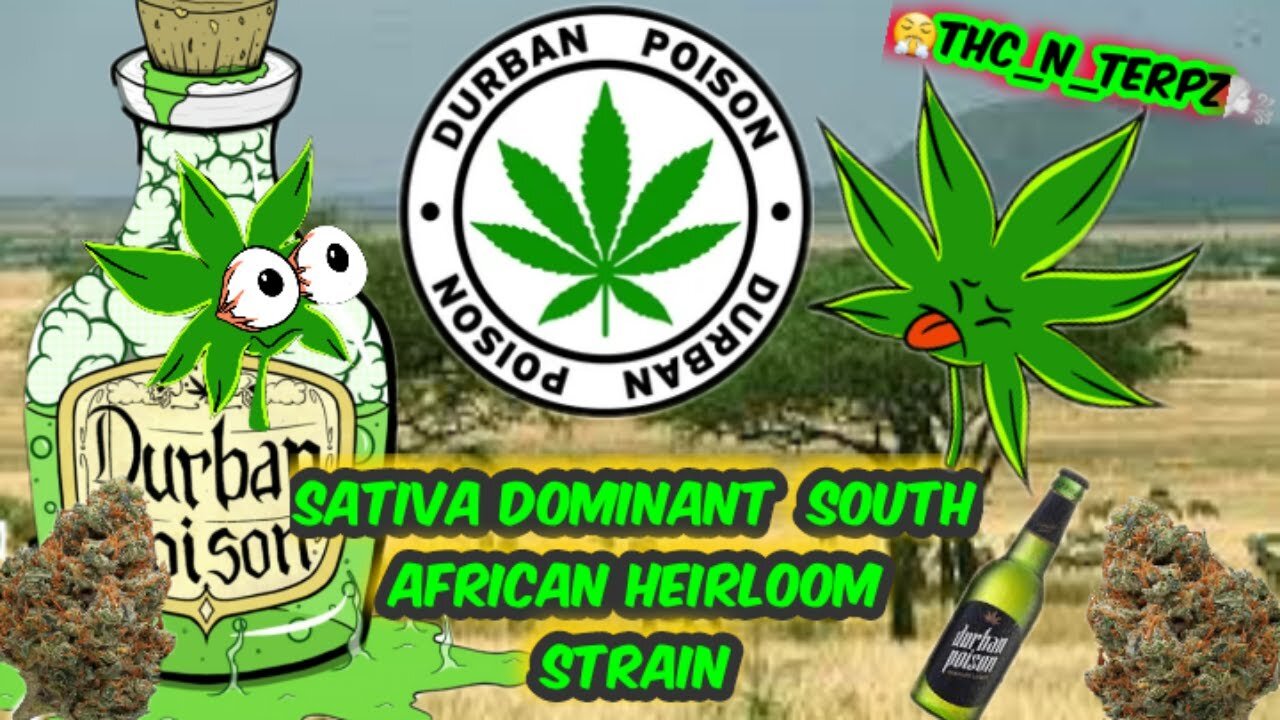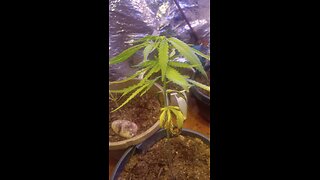Premium Only Content

DURBAN POISON-🐅SOUTH🐘AFRICAN LANDRACE / HEIRLOOM Genetics - The Original Sativas
Locals
THCnterpz.locals.com
Social Media Linktree
Linktr.ee/terpene.king
Support Independent cannabis Research And development
https://bmc.link/DocTerpology
Durban Poison is a South African landrace Sativa, which means the genetics have no indica genes in them, they are 100% Sativa. Many consider the energetic uplifting note of Duban Poisons Piney earthy lung filling smoke is great for the wake n bake session, having very little body effect to sedate but very focused on the heady aspects of cannabis intoxication. Depending on ones sensitivity to the terpenes presented in the particular batch of Durban Poison one may find the strain to anxiety provoking causing jitteriness and anxiety or it may lead to a less traumatic energetic high.
However, i describe my thougjts about the paranoia aspect below. The likloehood of Durban being a freak out strain is low, given its souther equitorial landrace location. I explain this below. These are very stable genetics when compared to the hybridized strains we see kn the markets today. The presence of Landrace genetics in cannabis can drastically alter to product of the cannabis descendents several generations down the line.
For example, crossing a landrace with nothing but hybrids, the genetic markers characteristic of that landrace used will be notable almost always in some way over the hybridized characteristics.
Durban Poison hails from South Africa and was brought to the United States in the 1970s by one of the teroene kings of cannabis culture himself, Ed Rosenthal. The Durban Poison Strain hails from the port city of Durban, which makes sense when you take the terpological application into consideration.
While it doesn't have the Jungle environent, being a port city in south Africa one can intuit the type of climate and envirmoent present there. It is also sensible imo because like the asiatic jungles, the competition for the sativa and other life in this area is much higher than that which the Indica faces for example on the Afghani Steepe. I have thought about this for some time now and wondered how exactly sativas were able to be dominant over jndica in an area I would consider to be suitable to the indica.
If I consider the African Savanah, I don't think sativa, but when I consider the humidity of the air and climate of a port city, it starts to make a lot kore sense that both Indica and sativas are present in these African Climates, similar to the carribean, although it I would argue is more suitable for sativa all around being island Tropics, but it falls into that same line of thinking as how does Africa produce landrace sativa and Indica. Indeed the African Savanah isn't exactly typical sativa landrave territory, but the humidity that would be present in such a port city in such a hit area would be significant, making the appearance of this uniquely defined sativa landrace more understandable. It also offers validation for my analysis that indica is born of sativa cannabis, it is a form of sativa. Insay so because of the Purples in Durban Poison. The purples are a reaction to the cold and is expressed through a compound known as Anthecinin, activated by cold temperatures. The leaves also turn a deep purple upon flowering stage as the energy moves into the tricomes for production thereof and stops focus on photosynthetic activity. Photosynthesis utilises the green chlorophyll ofnthe plant, hence the turning purple of the leaves, somewhat different than the anthecinin indiced purples of buds. Even the density of Durbam Poison speaks to a denser structure more indica like than sativa Imo. It's definately a unique example beyond just being a sativa from places outside the big 4 areas,Afghanistan, asia, mexico and south america.
Because when we consider other landrace, like Afghani, it is the product of a desert steepe, we aren't going to find a 20 foot tall light green aerated bud tructure plant with thin leaves standing alone thriving in the desert, they simply require different things, save someone tending to then, I. Speaking g on natural growth or unattended growth.
Durban Poison offers an uplifting energetic buzz but I would like to define the meaning exactly of ENERGETIC. I have noted before the difference I feel is present between saticas of differing descent, and I have related that difference mainly to the location of the landrace genetics. Plants that are grown north of the equator In the Asiatic Tropics and Mendicino Triangle tend to be very energetic and uplifting in energy, at times in some recreational strains, which follow the extemification of any substance made illicit desired by society, luckily cannabis just enhanced the natural psychedelic characteristics, but this still is exhibited in sativas by making the strains super anxiety provoking.
However those grown South of the equator, like Durban Poison and South American sativas tend to uplift the mood and not be as energetically amped. I have discussed this issue before and there's reason why I say north if the equator, and it's also important to define why Sativas and namely sativa hybrids produce such strong anxiety provoking effects. The reason these sativa hybrids on the US market are so intensely psychoactively psychedelic is due to the excessive levels of Beta Myrcene, and the diminished presence of nore sedating teroenes in the profiles like beta caryophyllene, or even Trans caryophyllene and terpinolene, the natural anxiolytic that makes those South American strains more relaxing.
When myrcene is left on its own, meaning there is not any Beta Caryophyllene present, which in sativa is typically going to be in Trans Caryophyllene form as this is the most common form of Beta caryophyllene, while it makes up 37% of most cannabis sativa oil as Trans caryophyllene, when it is not present at all the myrcene has a totally different reaction within one's endocannabinod system. Myrcene alone acts to enhance the proliferation of absorption of THC across one's Blood Brain Barrier.
That barrier is a semi permeable barrier that keeps the blood in one's body seperate from thebblood in the brain, only allowing pertinent compounds able to pass through the membrane. Durban Poison is also quite high in THCv known to suppress appetite. Interesting to my notes on the presentation of structure being incdica like, looking at the terpenes of Durban one also sees indica characteristic expression, having alot of linalool and humulene, but the terpinolene is the giveaway, and explains the less hyped experience alongside the above mentioned myrcene phenomena egged on by the inherent extremification I've discussed in past of any illicit substance desired by society. Lucky for us cannabis just got super heady through the proliferative terpene myrcene & it's extensive dominant profile presence in 48% of cannabis.
If the myrcene is paired with Trans caryophyllene which is the most common way the two are found in sativas if not alone, the myrcene is slightly less intense, but Trans caryophyllene isn't as sedating as myrcene is when it is paired with Beta Caryophyllene, which is typically how it appears in cannabis indica Hybrid.
The reasoning behind myrcnes amplification though goes beyond just the extremeification concept. Myrcene enhancement is also an inevitable occurrence given the way cannabis is grown in the United States, being mostly hybrid cannabis being desired to get the best of both worlds essentially. I also believe it was somewhat inadvertent, not totally Knowing 'myrcene is enhancing things' for ex.
Since myrcene is dominant in 48% of all cannabis on the US shelf, this alone means there's a higher percentage chance to get a dominant myrcene expression, but then take a sativa and indica and br seeking hybrids and it increases that possibility even further. Free cannabis. I want to note here that Beta caryophyllene is an amazing anecdote to the psychoactivity that causes severe paranoia and anxiety and can be utilized by using black pepper from your spice cabinet. If you experience a high that's too intense on the sativa lean, simply ingest a.few black pepper cereals as they are very high in Beta caryophyllene, this will interact with the teroenes present in the cannabis specifically due to some qualities unique to beta caryophyllene allowing it to interact with those compounds when ingested orally.
Terpenes that are chara teristic of a sativa are Terpinolene, ocimene, pinene (both alpha and beta), sabinene, Trans caryophyllene, & myrcene (there's a special caveat w/myrcene). The Pinene is a special case because it has in its characteristics qualities that make beta pinene representative of indica quality more than sativa and sativa quality in Alpha Pinene moreso than characteristic of indica. I judged this initially seeing beta pinene in higher levels alongside humulene jn indica cannabis with very rank skunk undertones.
The skunky aroma the piney skunk of indicas isn't really the most natural form of that aroma, indica is very earthy and musky. But when beta pinene presents in Indica Hybrid we get the aroma that prompted production of much of the cannabis on the illicit market, which I discuss as a phenomena that provoked the production of certain Types of cannabis over others in an inadvertent manner on a subconscious societal level during cannabition. Meaning that people hated the smell of the indica which reminded them of the Mexican brick pack cannabis, and with the limited knowledge, Growers sought to produce cannabis that would sell quickly, an inherent issue In any illicit substance as the goal is max income and not being caught, so increasing potency and making strains that present the way buyers want over trotters helps this process.
That continues and we have a market very dominated by sativa characteristics, although that is changing with more states taking over someof that huge slave of the market that was being supplied by California both within the United Staes and World wide.
Landrace sativa are great for anxiety issues, as they have natural levels of terpinolene to other terpenes, bot all sativa is meant to have such an energetically hyped up experiential profile. Those characteristics are exaggerated by hybridization to satisfy an illicit market. If you think of an illicit strain, you think either midis, which is a colloquially used term for mid grade sensimilla cannabis that presents with that sativa aroma and usually a nice dense indica structure w slightly elongated tight triangular nugs. This tested approx. 7% o. Low end to 18% max on the upper end. That
It is cannabis that's produced specifically on and for the illicit market and it is less present even in my state of Maryland as that cannabis tends to deplete with the introduction of medicinal cannabis to states. Diversion of the market to illicit sales takes over that midis market.
The manner in which the country has legalized cannabis has pushed the industry against a wall, or between two walls where the black market, at this point won't get stamped out by legalization. The state is too focused on vreating a capitalist industrialized culture and presenting opportunity for an illicit market to maintain. If things would be more open, financial barriers to entry weren't so sky high, the illicit market would disappear much more quickly and the risk of fety was laced cannabis or love boat wouldn't even be a thought for anyone regardless of where you purchase the cannabis.
Durban Poison tests at approximately 24% THC making it one of the stronger presenting THC strains of landrace genetics. Remember landrace is the 100% genetic present in Nature, heirloom is what is grown in the Lab or closet not in its natural endemic enviroment. The physical presentation of Durban Poison would fool some novice, or me into believing maybe it has Indica Quality to it.
I believe this is because of what I discussed regarding climate, the port humidity being near the ocean and warmer climate makes an enviroment suitable for sativa, but there very likely indica thriving here as well, and there is that can be looked up online, like Black beauty an African indica. The plant isn't seeking to overgrow jungle ground foliage or stretch to reach the light breaking through the canopy, which would in my thinking push the plant to present like more of an indica In Height.
Durban poisons ability to adapt so well to various Grow enviroments also speaks to this nature of the strain, as indicas are much more hardy than a sativa just due to the climate and weather they deal with naturally as a landrace. I also think it speaks to the fact that areas outside the main 2 regions of earth the climate & weather etc is such that even landrace presents somewhat hybrid looking, dark dense buds.
Durban Poison has been cultivated on the African continent since the late 14th century. Certain tribes of South Africa were known to have cultivated this landrace cannabis and accepted its use ampungst themselves culturally. The Bantu and other African tribes referred to this plant as "dagga".
In the 70s Ed Rodenthal brought back a bag of Landrace Seeds to the United States and developed 2 lines of Durban Poison which was reffeerred to as A and B strains. MEL FRANKS then went and further lessened the flowering time while the B line was given to Growers in Amsterdam.Specifically a Grower named Sam the Skunkman Seedman lessened the flowering time even further. This was around the time period when Sea of Green techniques were being experimented with in Amsterdamn to create faster flowering cannabis, allowing for 2 and 3 harvests per years rather than at max 2.
The effects of Durban Poison are right in line with what is expected from a sativa genefic, despite the appearance of the plant and bud structure that appears very much so indica like. My observations about the pistols, the fact that sativas have elongated scraggly pistols to catch pollen, and that in jungle enviroments endemic of sativa the air is more humid not allowing pollen to float as easily,making the plant'reach' further to get that pollen. While the indica is in a dry arrid area where the pollen can blow directly to the plant.
DurbaN POISON PRESENTS W/long DARK GREEN BUDS WITH SHORTER DARKER ORANGE PISTOLS, indica Presenting. However, the elongated bud structure n different micro structure seperates it.
The further I got into this breakdown, the more confident I am that Durban Poison presents as it does, as not a very expressive characteristic sativa and having qualities physically characteristic of Indica is highly related to the area in which it is grown is more of an influence than the degree to which i may have given credit.
It makes alot of sense that the humidity of the enviroment and the lack of colder nights is one of the main influences environmentally on sativa expression. The more humidity and rain present, the more sativa expression is pushed Is the thinking here.
I also wonder what the implication is of that rain on the plant in so far as stressing the plant throughout its life. I wonder if cannabis has adjusted to not be effected by the inevitable stress inherent to rain drops and wind poulverizing the plant in jungle enviroments, or if that rain causes stress the the plants. That stress may be the key in expressing the sativa characteristics.
However, I don't think that's everything, as my area isn't a rainy area yet indica dominant hybrids grown here present with very sativa leaning qualities like a terpinolene dominance and diminished indica terpenes like linalool, limoneme, and humulene. It indeed could be the Climate, the altitude of the area where cannabis is grown may in favt be the most impactful aspect of manipulating strain lean. Gorilla Glue by Grow West here in my area presents terpinolene dominant...
Full review 👇
https://www.patreon.com/posts/durban-poison-n-81789208
-
 28:55
28:55
tErPwErKz710
11 months agoIts that time ..... lemon Cherry Gelato Time w that Crazi Koala Guy
58 -
 11:49
11:49
Nikko Ortiz
14 hours agoCrazy Instant Karma Clips
2.75K4 -
 16:21
16:21
Actual Justice Warrior
20 hours agoSuper Mayor Replacement SCAMS Voters
1.15K7 -
 10:17
10:17
Dr Disrespect
3 days agoIt's Time To Get Serious
147K20 -
 2:04:24
2:04:24
Side Scrollers Podcast
19 hours agoColbert CANCELLED, Donkey Kong Bananza “Disappointing”, $100k in Pokémon STOLEN | Side Scrollers
9.33K6 -
 1:17:57
1:17:57
Omar Elattar
1 month ago"The #1 Health Protocol" – Gary Brecka REVEALS The Longevity Secrets of Ronaldo, Dana White & Top 1%
12.8K -
 21:29
21:29
GritsGG
14 hours agoUpdate Your Loadout w/ This KILO Sniper Support Build!
8.12K1 -
 LIVE
LIVE
Lofi Girl
2 years agoSynthwave Radio 🌌 - beats to chill/game to
585 watching -
 10:29:07
10:29:07
SpartakusLIVE
13 hours agoFriday Night HYPE || WZ Solos, PUBG, and maybe even OFF THE GRID?!
98.2K -
 3:24:24
3:24:24
megimu32
8 hours agoOFF THE SUBJECT: FAFO FRIDAY - Bodycam Madness + Mortal Kombat Mayhem!
57.5K10